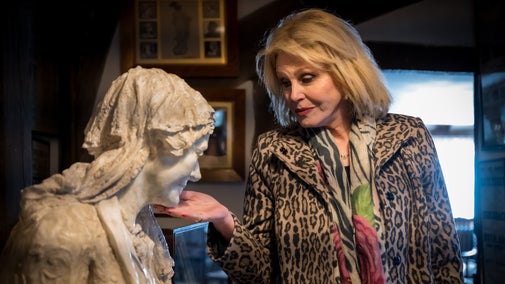
Discover more at Smallhythe Place
Find out when Smallhythe Place is open, how to get here, the things to see and do and more.

Born into a family of travelling actors, Ellen Terry was immersed in the world of theatre all her life. With over 9,500 artefacts from her personal and professional life, the collection here explores her history and unravels hidden secrets of how she became an international celebrity of the late 19th and early 20th century. The compact little museum at Smallhythe Place plays homage to her life and career.
When she died in 1928, Ellen Terry left all her remaining property at Smallhythe to her daughter, Edy Craig, who was determined to establish Smallhythe Place as a museum in honour of her late mother. With much financial difficulty, a year later Edy successfully turned the house into a museum and the barn into a working theatre. In 1939 Edy gifted the property to the National Trust.
Edy rearranged many of Smallhythe’s rooms to create displays relating to Ellen’s life. Apart from the Library and the Costume Room, the current layout of the rooms departs very little from Edy’s original arrangements. Smallhythe Place therefore survives much as E.V. Lucas described in 1936, filled with mementos of Ellen’s life and career, and still ‘pulsating with [her] personality’.
Used by Ellen as a sitting room, this room now explores Ellen’s professional and personal background.
Costume sketches by Edward Burne-Jones and a portrait of Ellen as Joan of Arc by G.F. Watts (Ellen’s first husband) hang on the walls and portray Ellen in various roles throughout her time on stage. A scroll produced to commemorate her 50-year Stage Jubilee in 1906 takes centre stage above the fireplace, and the insignia with which she was presented when she was made a Dame Grand Cross of the British Empire serve as reminders of her professional achievements.
Alongside these sit more intimate mementos of Ellen’s life including her birth certificate, her family tree and her ‘friendship necklace’, compiled by Ellen from beads given to her by family and close friends.
The Dining Room now explores the actress’s connections with leading artists and performers of her generation and documents key moments in her 60-year career, bringing insight into the theatrical world within which she rose to distinction. However, the room also retains many social and private elements of how it was during Ellen’s time here.

This was formerly the kitchen, and Ellen turned this area into her dining room when she arrived at Smallhythe Place. It was somewhere informal to gather with friends and family and sit around the fire during the cold winters. To this day, her wooden settle remains in its original position on the right-hand side of the 16th-century fireplace.
Today the Dining Room echoes Smallhythe’s new identity, a conversion from a private home to a public memorial. The original cases with their hand-written labels installed by Edy Craig are still on display.
Once a bedroom, the Lyceum Room now showcases Ellen’s stage career, focusing on her time as leading lady at the Lyceum Theatre where she worked with Henry Irving. The display cases and cabinets contain a diverse collection of mementos from Ellen’s many performances, including the dress robes she wore when playing Portia in The Merchant of Venice. Among other stage props are sketches and photographs connected to Henry Irving, who became manager of the Lycuem Theatre in 1878.
In 1968 this room was converted into a library where Ellen’s books, originally kept ‘mainly just in piles’ distributed around the house, were all brought together. Today over 3,000 books can be found in here.
These books are filled with marginalia, as F.T. Bowyer said: ‘The charm and interest of the books is due largely to their owner’s copious comments and annotations’, from theatrical biographies of her contemporaries and predecessors to play texts she appeared in or studied, including her series of lectures on Shakespeare. The collection is filled with hidden history and Ellen’s passion for literature.

Perhaps both the most personal and intimate room at Smallhythe, the bedroom retains its original layout and shows how Ellen used it throughout her time living here.
Radiating a tranquil and calm ambience due to the absence of artefacts connected with Ellen's career and celebrity status, the focus of this room is instead on her personal life, her relationships as a mother, daughter, sister and a woman in her own right.
The furnishings here served a practical purpose or had a personal connection to Ellen; the well-worn school desk was originally purchased for her children and used by Ellen throughout her life for letter writing, the dressing table designed by Edward Godwin overlooking the road and Yew Tree Cottage, and the round table, still laid for tea, illustrates the room becoming both her sitting room as well as her bedroom in her later years.
The photographs on the surrounding walls show family and the people who were dearest to her. Among them is a pastel portrait of her mother, Sarah Terry.


Find out when Smallhythe Place is open, how to get here, the things to see and do and more.
Discover the history of Smallhythe Place, from a centre for royal ship building to the home of Ellen Terry, one of the most famous Shakespearean actors of the Victorian times.

Find out about the work we do in the winter months to maintain and conserve the museum, house, theatre and garden at Smallhythe, ready for the next season, including costume conservation.

Joanna Lumley follows in some famous footsteps as patron of the Barn Theatre. Discover how her local connections, love of the stage and acting pedigree make her the perfect choice.

Discover this charming cottage garden surrounding the house, with borders packed full of flowers, an orchard underplanted with bulbs and roses tumbling over the front of the house.
